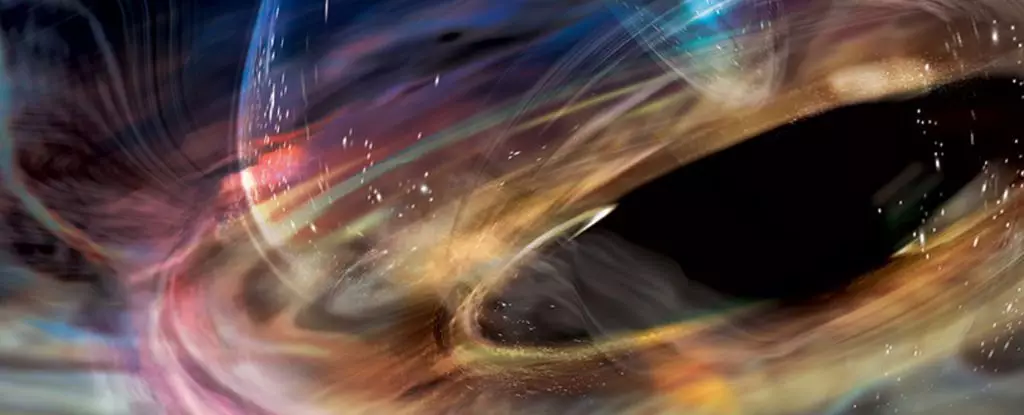Deep in the cosmos, 275 million light-years away from our home galaxy, the Milky Way, lies an astronomical conundrum known as 1ES 1927+654. At its core resides a supermassive black hole, which has drawn the attention of astronomers and astrophysicists due to its unusual behavior. This celestial body has long puzzled researchers, but recent discoveries hint that a white dwarf star—a remnant of a low-mass star nearing its end—may be responsible for some of the black hole’s strange antics. This intriguing relationship prompts a closer examination of how such celestial dynamics unfold in the extreme environments surrounding black holes.
Black holes are notorious for their insatiable hunger; they consume everything that strays too close, enveloping themselves in an aura of mystery. One might think that these entities would be entirely devoid of light, overshadowed by their all-consuming gravitational pull. However, they are often surrounded by luminous accretion disks made of gas and dust that are heated to incandesce as they spiral inward. The interplay of gravitational forces and cosmic materials produces observable phenomena, helping scientists probe the secrets of these elusive giants.
In the case of 1ES 1927+654, things took a compelling turn in 2018. The black hole’s corona—a structure comprising hot gas—suddenly dimmed, only to brighten spectacularly, reaching luminosities approximately 20 times greater than previous levels. Such fluctuations do not follow a conventional pattern observed in other black holes, leaving researchers scratching their heads. Investigations into this peculiar behavior suggested multiple possibilities, including theoretical phenomena such as black hole polar reversals. Yet, the enigma persisted, beckoning further inquiry.
Continuing observations in the ensuing years provided valuable data that illuminated a pattern within this cosmic puzzle. By June 2022, astronomers utilizing the European Space Agency’s XMM-Newton space telescope reported dramatic changes in the X-ray emissions from the black hole, evidenced by brightness oscillations. These variations were not only notable; they occurred over an increasingly shorter time frame, decreasing from roughly 18 minutes to about seven. This rapid fluctuation signaled that something extraordinary was occurring in the vicinity of the black hole.
Understanding the significance of the light emitted and its changes was crucial for discerning underlying dynamics. To comprehend such phenomena, the research team employed imaginative theories about what could be causing these aberrations. The precise timing and variability of brightness suggested an object, likely an astronomical body in orbit around the black hole, was closely approaching the event horizon—the boundary beyond which no information or matter can escape.
Upon thorough investigation, the researchers identified a dense object—presumed to be a white dwarf star—spiraling inward towards the supermassive black hole. This collapsed remnant of a once vibrant star, surviving its initial cataclysmic phase, represents a fascinating component in this cosmic interplay. The emergence of such a star close to the event horizon raises intriguing questions about its fate, highlighting the resilience of white dwarfs due to their extreme density.
It is predicted that this white dwarf, possessing approximately one-tenth the mass of the Sun, is experiencing tidal forces as the black hole’s gravity tugs relentlessly at its exterior. Strikingly, while the core remains intact, the outer layers of the star may begin to be stripped away. This shedding could provide enough momentum for the white dwarf to evade total devastation, supported by its density and structure, possibly allowing it to maintain a precarious orbit around the black hole. Should this scenario hold true, researchers could observe shifts in the periodicity of the X-ray oscillations, suggesting the white dwarf’s gradual retreat to a safer distance.
As the revelations surrounding 1ES 1927+654 continue to unfold, astronomers are reminded of the universe’s capacity for surprise. The journey toward understanding the dynamics at play around black holes has only just begun, and this particular cosmic locale may yield further insights into the fabric of spacetime and gravitational forces. Each new discovery could deepen our grasp of extreme celestial environments and the life cycles of stars.
Megan Masterson, a physicist from the Massachusetts Institute of Technology, cautions on the unpredictable nature of this unique black hole. The unfolding narrative—the ongoing cosmic dance between the white dwarf and the supermassive black hole—demands that scientists remain vigilant and inquisitive. The coming years of observation promise to shine a deeper light on the symbiotic relationships that influence the fate of stars and the enigmatic behavior of black holes, pushing the boundaries of our cosmic knowledge ever forward.


Leave a Reply